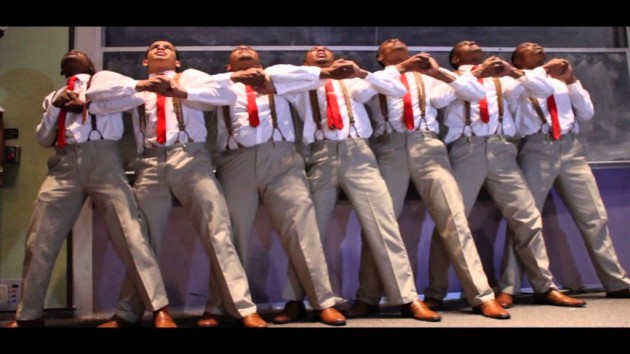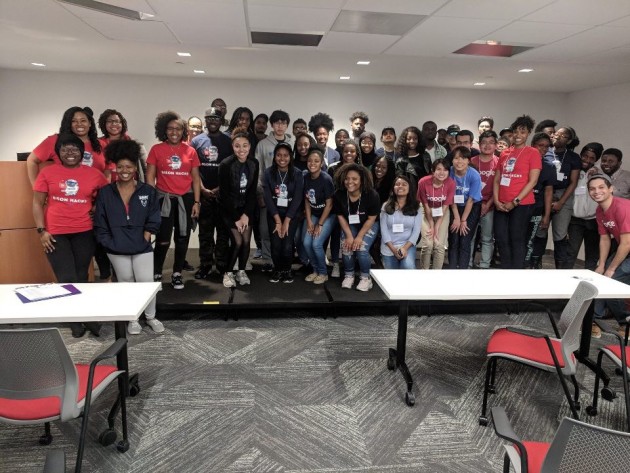Smoke filled the air as raging fires engulfed buildings. Distraught men and women took to the streets, and in the end, much of an area lay in wreckage. That was the scene in Northeast Washington’s H Street Corridor in 1968 after the assassination of Rev. Martin Luther King Jr.
Today, the orange cones, nets, caution tape, broken gravel and construction workers laying rails for a streetcar line are telltale signs of a vigorous, $33 million rebirth attempt. So are the sounds of jackhammers mixing with the sounds of passing cars.
The shops, eateries and nightclubs on H Street are as diverse as the people who live there or travel there for entertainment, goods and services. They are young and old, and of many hues. The residents and patrons of the H Street Corridor and the surrounding area have an array of opinions when it comes to the renewal underway.
“You got homeless people, people without jobs. What are they doing for them?” said Jack Spud, a carpet installer who has lived in the H Street area for more than 40 years and now resides on G Street.
Spud, 54, said to restore vibrant life to the area the focus should be on the people living there, not on concrete projects. He is among the people in the community who say there should be more recreational and social options for the young people of the community.
Forty-four-year-old Karen Harris is also a long-time resident of the H Street area, and she recently began working as house manager for H Street’s Atlas Performing Arts Center. She said the restoration of H Street is a Catch 22. It’s nice, but she is concerned that the changes are aimed more at meeting the needs of mainly young white professionals new to the neighborhood than the needs of some long-time residents.
According to Karyn Le Blanc, the director of communications for the District Department of Transportation, the total cost for the H Street project is approximately $33 million. The portion of the $33 million that has been allotted to install the streetcar would be better directed toward “Ithe homeless, to the people who have nowhere to go, to the children who don’t have enough to eat,” said Harris who also maintains that the money should go toward education. “We take our money and do all these other things,” she said.
The H Street Corridor stretches across 13 blocks, equaling about a mile and a half. The streetcar line will provide service between the Gallery Place/Chinatown and Minnesota Avenue Metro stations.
According to Anwar Saleem, executive director of H Street Main Street, the line will run from Anacostia to Benning Road and then to H Street. He said the Department of Transportation is trying to get a federal government grant to extend the streetcar line to Union Station. Its advocates believe the project will make the entire corridor more accessible while reducing traffic congestion and parking woes.
The area’s facelift not only includes the streetcar line but also the addition of trees, sculptures, lights and better sidewalks.
Saleem, 55, grew up in the area and witnessed both the 1968 riots and the current revitalization initiative.
He recalled one of his most memorable moments riding the streetcars that were once on H Street. “I lost the first pair of pants my mother gave me,” said Saleem who was about 7 years old when he left his jeans sitting in a bag on the streetcar.
Despite the negative image of H Street perpetuated by the media in the past, Saleem says, “It was always a warm quarter. It has always kept its warmth and closeness.”
The area is rebounding, Saleem said, adding that in the last year alone, 15 businesses opened on H Street.
Fifty-nine-year old Charlene Anderson, the owner of a children’s clothing store, “Merry Go Round” at 1244 H St., sits at her cash register facing two large pictures of her granddaughters, her inspiration for opening the store.
With the melody of “That’s The Way of The World” by Earth Wind and Fire in the background, she contemplated the changes occurring right outside her window.
“I think it’s going to be nice in the long run. However, it interferes with the business—because customers don’t have anywhere to park,” said Anderson, who has been running her business on H Street for three years. “A lot of times they think we’re closed. There was one time they cut the water off. It’s taking longer than it should.”
Anderson suggests that H Street needs grocery stores and more businesses that everyone can enjoy. “I think it needs to cater to all of the people and not just some of the people,” she said.
Washington native June Sykes, 50, a retired mental health counselor has lived in the area for five years consecutively. He spent his childhood living back and forth between the District and Virginia as his mother pursued a career in government. He welcomes the change coming to H Street but has some reservations, too.
“It’s real hectic, hard for traffic to get through, but overall I think what’s trying to come to H Street is good,” he said. “But what I’m not getting and what I’m not understanding is—the streetcars were here once before. Why are they bringing them back? Why didn’t they just keep them while they were here?”
The original streetcar line was removed in the early 1960s due to the rise in automobiles. Sykes shares the view that the streetcar project is less important than the area’s need for recreation centers for children.
“Streetcars are not real important, because we have a bus line that’s very good,” he said.
Sixty-three-year-old Charles Brooks, a retired writer at the Library of Congress, has lived on Benning Road near H Street since 1989. Cheap rent in the 1980s attracted him to H Street, and he said he doesn’t want to leave the area.
“This is where everything is coming,” said Brooks, who laments but understands the rising rent in the area. “You have to pay for what you want.”
Brooks appreciates all of the changes coming to H Street and said everyone, especially young people, should try to enjoy the changes.
“It’s bringing jobs to the area, and that’s one of the most important things,” he said. “A lot of young people, teenagers who are still in high school or just leaving high school—should not have to go too far to find something to do. It’s right in their reach, and all they have to do is reach up for it.”




